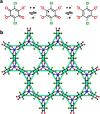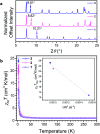Synthetic investigation of competing magnetic interactions in 2D metal-chloranilate radical frameworks
- PMID: 34094085
- PMCID: PMC8159288
- DOI: 10.1039/d0sc01994a
Synthetic investigation of competing magnetic interactions in 2D metal-chloranilate radical frameworks
Abstract
The discovery of emergent materials lies at the intersection of chemistry and condensed matter physics. Synthetic chemistry offers a pathway to create materials with the desired physical and electronic structures that support fundamentally new properties. Metal-organic frameworks are a promising platform for bottom-up chemical design of new materials, owing to their inherent chemical predictability and tunability relative to traditional solid-state materials. Herein, we describe the synthesis and magnetic characterization of a new 2,5-dihydroxy-1,4-benzoquinone based material, (NMe2H2)3.5Ga2(C6O4Cl2)3 (1), which features radical-based electronic spins on the sites of a kagomé lattice, a geometric lattice known to engender exotic electronic properties. Vibrational and electronic spectroscopies, in combination with magnetic susceptibility measurements, revealed 1 exhibits mixed valency between the radical-bearing trianionic and diamagnetic tetraanionic oxidation states of the ligand. This unpaired electron density on the ligand forms a partially occupied kagomé lattice where approximately 85% of the lattice sites are occupied with an S = ½ spin. We found that gallium mediates ferromagnetic coupling between ligand spins, creating a ferromagnetic kagomé lattice. By modulation of the interlayer spacing via post-synthetic cation metathesis of 1 to (NMe4)3.5Ga2(C6O4Cl2)3 (2) and (NEt4)2(NMe4)1.5Ga2(C6O4Cl2)3 (3), we determined the nature of the magnetic coupling between neighboring planes is antiferromagnetic. Additionally, we determined the role of the metal in mediating this magnetic coupling by comparison of 2 with the In3+ analogue, (NMe4)3.5In2(C6O4Cl2)3 (4), and we found that Ga3+ supports stronger superexchange coupling between ligand-based spins than In3+. The combination of intraplanar ferromagnetic coupling and interplanar antiferromagnetic coupling exchange interactions suggests these are promising materials to host topological phenomena.
This journal is © The Royal Society of Chemistry.
Conflict of interest statement
There are no conflicts to declare.
Figures



Similar articles
-
Chemical Design of Spin Frustration to Realize Topological Spin Glasses.J Am Chem Soc. 2024 Oct 23;146(42):29040-29052. doi: 10.1021/jacs.4c10113. Epub 2024 Oct 9. J Am Chem Soc. 2024. PMID: 39382197
-
Two-Dimensional Cobalt(II) Benzoquinone Frameworks for Putative Kitaev Quantum Spin Liquid Candidates.J Am Chem Soc. 2024 Jun 5;146(22):15061-15069. doi: 10.1021/jacs.3c14537. Epub 2024 May 24. J Am Chem Soc. 2024. PMID: 38787332
-
Exotic Topological Bands and Quantum States in Metal-Organic and Covalent-Organic Frameworks.Acc Chem Res. 2021 Jan 19;54(2):416-426. doi: 10.1021/acs.accounts.0c00652. Epub 2021 Jan 5. Acc Chem Res. 2021. PMID: 33400497
-
Quantum Anomalous Hall Effect in Magnetic Doped Topological Insulators and Ferromagnetic Spin-Gapless Semiconductors-A Perspective Review.Small. 2020 Oct;16(42):e1904322. doi: 10.1002/smll.201904322. Epub 2020 Sep 11. Small. 2020. PMID: 32914584 Review.
-
On-Surface Synthesis toward Two-Dimensional Polymers.J Phys Chem Lett. 2022 Sep 1;13(34):8062-8077. doi: 10.1021/acs.jpclett.2c01481. Epub 2022 Aug 23. J Phys Chem Lett. 2022. PMID: 35997300 Review.
Cited by
-
Linker Redox Mediated Control of Morphology and Properties in Semiconducting Iron-Semiquinoid Coordination Polymers.Angew Chem Int Ed Engl. 2022 Nov 7;61(45):e202207834. doi: 10.1002/anie.202207834. Epub 2022 Oct 7. Angew Chem Int Ed Engl. 2022. PMID: 36070987 Free PMC article.
-
Organic radicals stabilization above 300 °C in Eu-based coordination polymers for solar steam generation.Nat Commun. 2022 Oct 17;13(1):6116. doi: 10.1038/s41467-022-33948-9. Nat Commun. 2022. PMID: 36253477 Free PMC article.
References
-
- Chisnell R. Helton J. S. Freedman D. E. Singh D. K. Demmel F. Stock C. Nocera D. G. Lee Y. S. Phys. Rev. B. 2016;93:214403. doi: 10.1103/PhysRevB.93.214403. - DOI
LinkOut - more resources
Full Text Sources

